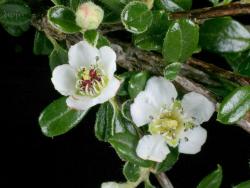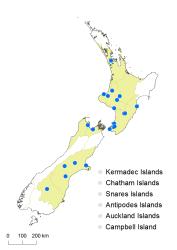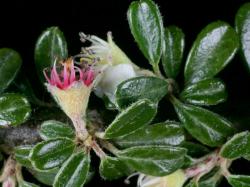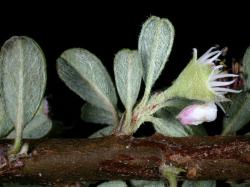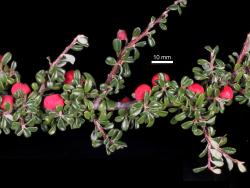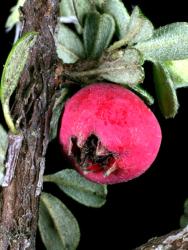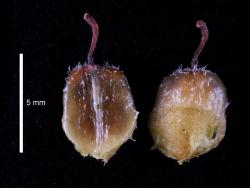Prostrate shrub 0.8 m tall, evergreen. Secondary branches not in one plane to somewhat aligned into one plane; branchlets red-brown, epidermis peeling, branchlet hairs moderately dense to dense, white or yellow; stipule 1.4–2.3 mm long, green or red, sparse to moderately dense, white. Leaves crowded on branches, 7.0–13 mm long, lamina 5.3–10.0 mm long, 3.3–6.0 mm wide, obovate, slightly V-shaped, 270–410 µm thick, petiole 1.7–3.0 mm long, dense, white; leaf base cuneate; leaf apex round, appearing emarginate, apiculus bent downwards; lateral veins not visible, midvein only impressed above and projecting below; upper surface smooth, mid to dark green, very glossy, upper surface hairs on young leaves sparse, on old leaves absent or confined to midvein; margins recurved, hairs moderately dense, straight, white; lower surface glaucous, hairs moderately dense, white, straight.
Flowers solitary, on branches 11–14 mm long with 4–8 leaves; pedicel 1.5–3.5 mm long, hairs dense, white. Flowers 8.5–10.5 mm diameter. Hypanthium green, red at sepal margins, sepals 0.9–1.5 mm long, 2.0–2.2 mm wide, hairs moderately dense, white. Petals pink-tipped in bud, spreading and white when open, 3.6–4.3 mm long, 3.7–4.5 mm wide, base slightly clawed, tuft of hairs absent, margins slightly irregular, papillose. Stamens 15–18; filaments 2.3–2.5 mm long, white, turning red after anthesis; anthers red-purple, 0.8–1.0 mm long; styles 2, rarely 3, 2.7–2.8 mm long. Fruit strong red (RHS 46A), oblate, 4.7–9.0 mm long, 6.4–11.0 mm diameter, calyx closed or partly open, hairs sparse. Pyrenes 2, rarely 3, 4.0–4.9 mm long, 2.7–3.6 mm wide, hairs sparse at apex, style attached at pyrene apex.
A prostrate shrub with long, unbranched, terminal branches. Leaves small, obovate, glossy and sparsely hairy or glabrous above (hairs persisting only in the midvein groove), glaucous below with moderately dense, straight white hairs that persist, margins distinctly recurved, base cuneate, apex appearing emarginate due to the apiculus pointing downwards. Fruit wider than long (oblate), vivid red with a slight waxy bloom and so appearing dark pink, with scattered white appressed hairs that disappear over time, fruit persisting over winter. Pyrenes 2–3, style attached at pyrene apex.
Most similar to Cotoneaster thymifolius but with larger leaves (lamina 5.3–10.0 mm long, 3.3–6.0 mm wide, not 4.5–5.6 mm long, 2.3–2.9 mm wide). Said to differ in how much pink is evident on the petals, but this seems to be only a matter of slight degree.
Similar to Cotoneaster integrifolius. Both have small leaves (5.3–25 mm long, 3.3–10 mm wide) that are obovate, slightly to distinctly V-shaped, thick in texture, margins recurved, moderately dense, straight white hairs on undersurface that persist; flowers solitary, petals white, spreading; fruit strong red but appearing dark pink due to a waxy bloom, pyrenes 2–3, style attached to pyrene at apex. Cotoneaster microphyllus has a glossier upper leaf surface, has smaller leaves that are less variable in size on one branch, the upper leaf surface hairs are sparse and in older leaves absent or confined to the midvein. The two are very similar and can be difficult to distinguish. The two species are equally common in cultivation but C. microphyllus is much more common in the wild than C. integrifolius.
Auckland (Mt St John, 1980), Volcanic Plateau (National Park, 1953; Raetihi, 1994), Taranaki (Waitaanga Plateau, 1998; Pūrangi, 1961,1956; Sentry Hill, 1961), Southern North Island (Whanganui City, 2007; Maraetōtara, 1973; Kiritaki, 1955; Waikanae, 2008; Woodville, 1974; Te Marua, 1950; Mangaroa, 1946; Karori, 1940–1945; Western Nelson (Ngārua Caves, 2004), Sounds–Nelson (Maitai R, 1959, Havelock, 1996), Canterbury (Port Hills, 1989, 2004; Mesopotamia Station, 1978; Māwaro, 2005), Otago (Cromwell, 1975). Common in cultivation throughout New Zealand.
Flowering: October to mid December; Fruiting: January to March
Tetraploid (Fryer & Hylmö 2009), confirmed by flow cytometry using CHR 635036.



